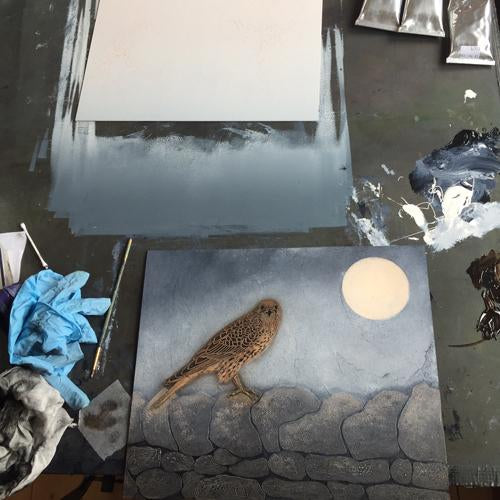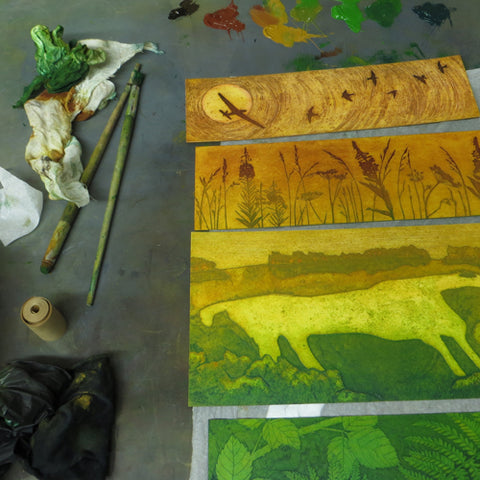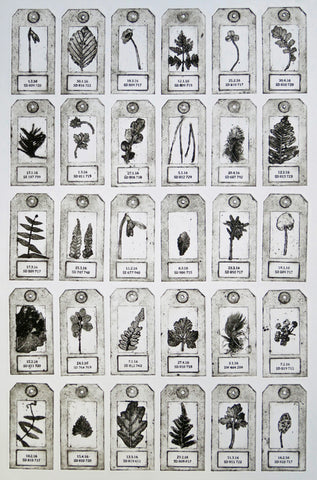Meet the Maker: Hester Cox

Hello! I’m full time printmaker specialising in collagraph although I do experiment with monotype, photo-polymer and relief print when the mood takes me!
I live in the beautiful Yorkshire Dales National Park and I’m also a keen fell runner. Much of my inspiration comes from the landscape and wildlife that I see whilst running.

Describe your process:
Generally, I get my inspiration when I’m out running or walking so I might take a few photos for reference and then mull over the idea for a while before I put pencil to paper. I sketch and play about with compositions, sometimes using a mirror to see what the plates will look like printed. I sketch out the final design and transfer it to the plate using tracing paper then I start painting on textures using gesso, adhesives and pastes. Sometimes I use collage materials such as textured papers or dried and pressed plants and I always use lots of cutting. When I’ve made my plate, I seal it using a shellac varnish. If it’s a multi-coloured print, I make base plates that I roll up with ink and print as blocks of colour and these will have the intaglio detail printed onto them. I’ve got two Rollaco etching presses, a bench model one and a portable press for workshops.

I dry my prints by taping the damp paper to a wooden board. As it dries the paper becomes beautifully flat and makes the print easy to frame. I usually print my collagraphs in batches of five or six at a time so I will go back and repeat the whole process. It can take anything from 15 minutes to an hour and half to ink and wipe one printing plate depending on the size and the complexity of the image. Then I clean everything using vegetable oil and rags.

How and where did you learn to print?
I did a BA (hons) Illustration at Harrow School of Art and Design and they had a good print department but I didn’t fall I love with print until my final year. I was doing a project on herbal medicine and was drawing and collecting medicinal plants. I wanted to use the plant material in the work but didn’t know how. A friend of mine suggested collagraph and was kind enough to show me how to make a plate from the dried and pressed plant material and I was hooked! When I graduated, I decided that I wanted to concentrate on printmaking. I moved north to Yorkshire to be with my partner and worked in a shop for a year to save up for an etching press. I then got a better part-time job, which allowed me time to work on building up a portfolio of prints. I’ve been a full time artist for the last 11 years.
These days I’m a member of two studios, Ålgården Printmaking Workshops in Borås, Sweden and Northern Print in Newcastle. Working at these studios gives me access to equipment that I don’t have in my own studio, time and space to experiment and the opportunity to work alongside other printmakers.

Why printing?
There is a lovely mix of careful planning and serendipity when you make collagraph prints. The plate making is a craft in its own right and you are only limited by your imagination and what materials you can physically get through the press. You can also change the look of an image so much when you are inking and wiping the plates. It involves a lot of methodical planning but the final ‘reveal’ is so exciting. You lift the paper from the plate and there is always an element of wonder. There’s also something pleasing about seeing your work in duplicate.

Where do you work?
I live at Horton-in-Ribblesdale in the Yorkshire Dales National Park and my studio is a lovely wooden building at the end of my garden. There is a field beyond which often has lambs in it during spring and a view of Pen-y-ghent (one of the Yorkshire ‘Three Peaks’).

Describe a typical day in your studio.
I don’t really have a typical day, which is part of the attraction! My weeks can involve gallery deliveries, lots and lots of admin, teaching workshops, framing, editioning existing plates or making new work. If I’m working all day in the studio, I’ll have breakfast then walk my dogs by the river or through the meadows. This really helps to give me energy for the day. If its winter I’ll then light the stove in my studio or if its summer I work with the door open and the sound of curlews and sheep. Like many artists, I listen to Radio 4 most of the day. Often I print well into the evening and only stop for a run or to have dinner with my husband. If I’ve got deadlines looming, I’ll often go back in and work until late.


How long have you been printmaking?
23 years! I’ve been printmaking since 1994 and made the leap to being a full time professional artist in 2006.

What inspires you?
The natural world! My mum is a doctor of zoology and a retired ecologist so it is through her that I’ve developed my love of natural history. I’m also a fellrunner and running is the perfect antidote to the solitary and sedentary life of an artist. When you run in the hills and in places people rarely get to, you see all sorts of wonderful wildlife. I am inspired by how the look of the landscape alters with changes in the weather and exhilarated when I glimpse a rare bird or animal. I want to share those often-overlooked details, the chance encounters or the transient things that people soon forget.

What products do you use? What product/tool could you not be without?
I use lots of acrylic gesso and wood glue for making the plates. My favourite paper for collagraphs is Somerset Satin made by St. Cuthberts Mill. I love my great big two-handled roller. I use it for creating graduated colour rolls on my base plates. I couldn’t live without my surgical scalpel. I use it for cutting into the mountboard (amongst many other things) and it is what I use to create fine detail. I get through lots of 10A blades!

What have you made that you are most proud of?
My most recent work ‘Within These Walls’. This is a large-scale print installation that I made to be hung in a field barn for the Grassington Festival. It has been the most challenging and difficult work that I’ve ever created and I’ve learned so much from it. It took six months to complete and consists of five 4-metre long printed voile hangings inspired by the upland meadows including an huge collagraph created by printing four 1-metre long plates in succession on an enormous etching press. I designed that part to be a cross-section through a bit of meadow reminiscent of when, as a child, I used to lay in the grass looking at the flowers and insects. At times it kept me awake at night worrying about the logistics and whether I’d finish it on time but it was all worth it in the end. Seeing the finished work installed from the beams of the barn as a light breeze moved the fabric and swallows flew in between was really magical.

Where can we see your work? Where do you sell?
I sell at various galleries across the country and they are listed on my website but one of my favourites is Masham Gallery. Josie Beszant is the owner and also an artist. She was the first gallery to permanently stock my work twenty-two years ago and we’ve become good friends. We are currently collaborating with ceramicist Charlotte Morrison on an on-going project called Collections. We are all avid collectors and we explore the idea of collecting and collections through our work. We’ve just has a successful exhibition at Ryedale Folk Museum Gallery. I also do one-off exhibitions at various venues, art fairs, print fairs and I sell work through my website although it is via the contact form and not ‘click and buy’ as I print in batches and need to make sure I’ve got one available.

What will we be seeing from you next?
I will continue to work on Collections with Charlotte and Josie and I am hoping to develop ‘Within These Walls’ creating large-scale collagraphs and monotypes on paper so that I will have a supporting exhibition to accompany the installation. I’ll also continue to make new collagraphs inspired by the natural landscape.

Do you have any advice for other printmakers and creatives?
Its hard graft to make a living as a full time artist but don’t give up! Work hard, believe in yourself, make the best work that you can and keep on developing your techniques.
See more of Hester Cox’s work on her website or on www.artistscollections.org. Follow Hester on Facebook, Instagram and Twitter for updates!
